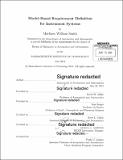Model-based requirement definition for instrument systems
Author(s)
Smith, Matthew William, Ph. D. Massachusetts Institute of Technology
DownloadFull printable version (23.88Mb)
Other Contributors
Massachusetts Institute of Technology. Department of Aeronautics and Astronautics.
Advisor
David W. Miller.
Terms of use
Metadata
Show full item recordAbstract
Instrument systems such as imagers, radars, spectrometers, and radiometers are important to users in the astronomy, Earth science, defense, and intelligence communities. Relatively early in the development cycle, performance requirements are defined at the top level and allocated to various subsystems or components. This is a critical step, as poor requirement definition and resulting requirement instability has historically led to increased cost and, in some cases, program cancelation. Defining requirements for instrument systems is uniquely challenging in part due to the divide between system users (e.g. scientists) and system designers (e.g. engineers). The two groups frequently differ in terms of background, objectives, and priorities, and this disconnect often leads to difficulty in evaluating and resolving requirement trade-offs. The objective of this thesis is to develop a model-based approach to requirement definition that addresses the above challenges. The goal of the methodology is to map science objectives to a set of top-level engineering requirements in a manner that enables traceability in the requirement hierarchy and facilitates informed trades across the science/engineering interface. This is accomplished by casting the requirement definition process as an optimization problem. First, an executable instrument model is created to capture the forward mapping between engineering decisions and science capability. The model is then exercised to find an inverse mapping that produces multiple sets of top-level engineering requirements that all meet the performance objectives. A new heuristic optimization algorithm is developed to carry out this task efficiently and exhaustively. Termed the Level Set Genetic Algorithm (LSGA), this procedure identifies contours of equal performance in the design space using an elite-preserving selection operator to ensure convergence, together with a global diversity metric to ensure thorough exploration. LSGA is derivative-free, parallelizable, and compatible with mixed integer problems, making it applicable to a wide variety of modeling and simulation scenarios. As a case study, the model-based requirement definition methodology is applied to the Regolith X-ray Imaging Spectrometer (REXIS), an instrument currently in development at MIT and scheduled to launch on NASA's OSIRIS-REx asteroid sample return mission in the fall of 2016. REXIS will determine the elemental composition of the target asteroid by measuring the solar-induced fluorescence spectrum in the soft x-ray regime (0.5-7.5 keV). A parametric model of the instrument is created to simulate its end-to-end operation, including x-ray propagation and absorption, detector noise processes, pixel read-out, signal quantization, and spectrum reconstruction. After validating the model against laboratory data, LSGA is used to identify multiple sets of top-level engineering requirements that meet the REXIS science objectives with regard to spectral resolution. These results are compared to the existing baseline requirement set, providing insights into the alternatives enabled by the model-based approach. Several additional strategies are presented to quantify and mediate requirement trades that may occur later in the development cycle due to science creep or engineering push-back. Overall, these methods provide a means of synthesizing and then evaluating top-level engineering requirements based on given science objectives. By doing so in a comprehensive and traceable manner, this approach clarifies the trade-offs between scientists and engineers that inevitably arise during the design of instrument systems.
Description
Thesis: Ph. D., Massachusetts Institute of Technology, Department of Aeronautics and Astronautics, 2014. Cataloged from PDF version of thesis. Includes bibliographical references (pages 199-210).
Date issued
2014Department
Massachusetts Institute of Technology. Department of Aeronautics and AstronauticsPublisher
Massachusetts Institute of Technology
Keywords
Aeronautics and Astronautics.